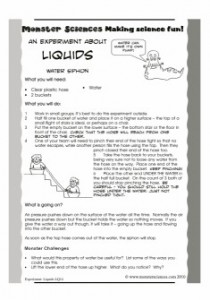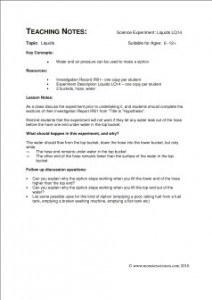Make a water siphon to study water pressure and movement.
 |
 |
An experiment about Liquids: Water Siphon
What you will need:
- Clear plastic hose
- 2 buckets
- Water
What you will do:
- Work in small groups. It’s best to do this experiment outside.
- Half fill one bucket of water and place it on a higher surface – the top of a small flight of stairs is ideal, or perhaps on a chair.
- Put the empty bucket on the lower surface – the bottom stair or the floor in front of the chair. Check that the hose will reach from one bucket to the other.
- One of your team will need to pinch their end of the hose tight so that no water escapes, while another person fills the hose using the tap. Then they pinch closed their end of the hose too.
- Take the hose back to your buckets, being very sure not to loose any water from the hose on the way. Place one end of the hose into the empty bucket. Keep pinching!
- Place the other end UNDER THE WATER in the half full bucket. On the count of 3 both of you should stop pinching the hose. Be careful – you should still hold the hose under the water, just not pinched tight.
What is going on?
Air pressure pushes down on the surface of the water all the time. Normally the air pressure pushes down but the bucket holds the water so nothing moves. If you give the water a way out though, it will take it – going up the hose and flowing into the other bucket.
As soon as the top hose comes out of the water, the siphon will stop.
Monster Challenges:
- What would this property of water be useful for? List some of the ways you could use this.
- Lift the lower end of the hose up higher. What do you notice? Why?
Teaching Notes: Monster Sciences Experiment: Liquids LQ14
Topic:
Liquids
Key Concepts:
Water and air pressure can be used to make a siphon
Resources:
- Investigation Record IR01– one copy per student
- Experiment Description Liquids LQ14 – one copy per student
- 2 buckets, hose, water
Lesson Notes:
As a class discuss the experiment prior to undertaking it, and students should complete the sections of their Investigation Report IR01 from ”Title to “Hypothesis”.
Remind students that the experiment will not work if they let any water leak out of the hose before the have one end under water in the top bucket.
What should happen in this experiment, and why?
The water should flow from the top bucket, down the hose into the lower bucket, but only while:
- The hose end remains under water in the top bucket
- The other end of the hose remains lower than the surface of the water in the top bucket
Follow up discussion questions:
- Can you explain why the siphon stops working when you lift the lower end of the hose higher than the top end?
- Can you explain why the siphon stops working when you lift the top end out of the water?
- List some possible uses for this kind of siphon (emptying a pool, taking fuel from a fuel tank, emptying a broken washing machine, emptying a fish tank etc)
Get this experiment here or as part of a bundle of Experiments about the Properties of Water here.



